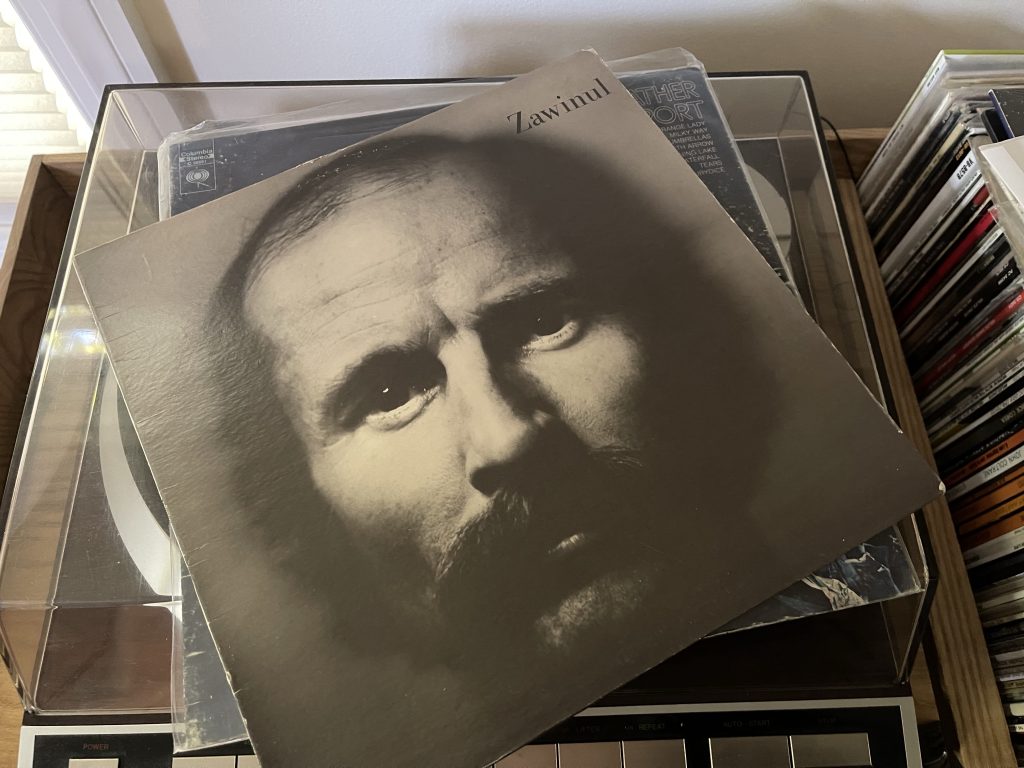
Album of the Week, September 17, 2022.
We last met Austrian keyboard player and composer Joe Zawinul when he arrived, seemingly from nowhere, to explore the unknown realms of in a Silent Way. On this appropriately self-titled album, Zawinul continues the journey, this time as leader and not merely as mystic guide. The album is a journey into outer space; it is also an instructive guide in the different ways to create jazz music.
Zawinul’s approach to this album was less group improvisation and more Gil Evans. The group features both Miroslav Vitouš and Walter Booker on bass, multiple drummers and percussionists (on different tracks, Billy Hart, Joe Chambers, Jack Dejohnette, and David Lee can be heard, usually in combinations of two or three), and a front line including Woody Shaw on trumpet (with Jimmy Owens on one track), George Davis on flute, Earl Turbindon on soprano sax, and Herbie Hancock on the mighty Fender Rhodes, alongside Zawinul on acoustic and electric pianos. One track features Wayne Shorter, Hubert Laws, and Dejohnette in lieu of Turbindon, Davis, and the other drummers. And the whole group performs in through composed suites that are strongly reminiscent of Gil Evans’ style, though still keeping room for solos.
“Doctor Honoris Causa” opens the album in a demonstration of this approach. The melody, written in honor of Herbie Hancock’s honorary doctorate from Grinnell University, is cut from the same cloth as “In a Silent Way,” with a slow chromatic drift of chords from the keyboards and the horns yielding to an insistent bass line supported by a steady backbeat. The front line then enters, with Turbindon, Shaw, and Davis playing the melody line with one voice as it circles the tonic before climbing up to a diminished sixth. There is a short break of around four measures before the second part of the melody returns, again in unison. Following the same arrangement pattern as some of Miles’ work on Nefertiti, the melody returns over and over again, with longer solos between. Shaw takes the first extended solo, his trumpet climbing over strong support from the Fender and Zawinul’s organ. Turbindon takes the next one, with his soprano sax exploring minor modes around the tonic and drifting away, with the Echoplexed Fender Rhodes of Herbie Hancock taking the next solo, reverberating through the cosmos. Zawinul takes the final solo, steering the group’s improvisations through turbulent air before gently bringing them to a landing. The work may celebrate Hancock’s accomplishments in title, but in execution it’s an evocation of flight.
“In a Silent Way” returns to Zawinul’s iconic composition that lent its title to Miles’ pioneering fusion album. Here we hear the work in its full extended form. In doing so, he gives us an insight into Miles’ compositional methods. The original arrangement heard here takes us through an extended introduction in multiple modal chord changes before bringing us to the famous melody. In doing so, the work takes on a very different character from Miles’ wide-eyed, searching rendition. At the last Tanglewood weekend of this summer, I heard WCRB commentator Bryan McCreath point out that much of the power of the opening of Beethoven’s Ninth Symphony comes from the open fourths and fifths that constitute the opening theme, because of their harmonic ambiguity. Minus a third in the progression, they could either fall to a major or minor key. The same is true of the Miles version of “In a Silent Way,” which keeps its progressions open for as long as possible before finally revealing its mode. Zawinul’s original extended introduction, which pivots from major to minor with richer harmonies throughout, is more fully voiced, but the ambiguity is lost. It’s still a stunning performance, evoking the Swiss Alps of Zawinul’s youth, albeit with less mystery and more sentimentality.
“His Last Journey” is a different animal altogether, a tone poem for bass, piano, chimes, and trumpet. The melody is played in the uppermost ranges of the arco bass over the second bass and a descending piano line, with the trumpet sketching an alternate melody around the edges. It’s a brief dream of a composition that is over all too soon.
“Double Image” is the outlier here. Recorded in a different session in late August 1970 with Shorter and Laws, the work is more of a group improvisation than anything else on the record, with the two keyboardists and two bassists alternately working together and improvising separately, with the extended bass arco solo at the beginning exploring the outer reaches. (I’ve gotten pretty good at telling the players apart on these albums, but am not sure whether we’re hearing Vitouš or Booker there.) Zawinul takes the other solo on the track, with the horns and flute providing the echo of the melody in between. The energy level and level of abstraction comes closer here to the more frenetic tunes on Super Nova and Bitches Brew than anything else on the record; unsurprisingly, this is the one composition from this period that would later be recorded by Miles’ electric group on Live-Evil.
“Arrival in New York” closes the album with something else again: a sound collage, with taped segments of bowed bass, organ, and percussion manipulated to evoke the cacophony of the New York streets, subways, and harbor as Zawinul remembered them from his arrival in the United States in 1959. As a composition it’s an island unto itself, but it would not be the last time Zawinul would embrace different studio techniques to discover new soundscapes.
So Zawinul points toward a different way to embody Miles’ searching while taking some of the great trumpeter’s collaborators in a different direction. He would continue working with Shorter and Vitouš; we will hear that collaboration next week.
You can hear the album here:
